Quick answer: For most job seekers, 1 page is ideal if you have less than 10 years of experience; 2 pages are fine if you have extensive experience or technical roles; 3+ pages only if you're in academia or senior executive positions.
Writing my first resume felt so stressful – I stared at the blank screen thinking How many pages should a resume be? Should it fit on a single sheet like a business card, or spread across two pages like a brochure of achievements? If you've ever asked yourself these questions, you're not alone. Many job seekers wonder how do I decide the best resume length? The answer depends on your experience level, industry, and the story you need to tell.
In this guide from JobHun, we'll walk you through resume length for both early-career and experienced professionals. You'll learn when to keep it concise and when a second page makes sense. We'll even share tools like our free AI resume builder and AI resume checker to help polish your resume. By the end, you'll know exactly how long your resume should be and why – no more guessing games! Not sure what a 1-page resume should look like? The free ai resume builder lets you choose templates that keep things clean and concise. And det instant feedback with our free ATS resume checker and see how recruiters (and machines) will read your resume.
Why Resume Length Matters
Your resume is like the cover of a book: it needs to grab attention and make a reader want more. In just a few seconds, a hiring manager will decide if they want to flip to that second page or call it quits. That's why clarity and relevance are king. Too short, and you might leave out important accomplishments; too long, and you risk overwhelming the reader. Job-search experts agree the ideal resume page length varies by person: typically one to two pages depending on your career stage. For example, resume guru Jack Kelly notes early-career pros and recent grads often do fine with one page, while mid- to late-career professionals usually need two pages to highlight a decade or more of experience. Got promoted at work? Make sure to highlight it correctly—here’s how to list promotions on a resume the right way.
Remember, content matters more than count. Indeed's career advice confirms that "resume length is secondary" as long as all included information is important and relevant. Focus on achievements and keywords, not filler.A resume isn't your full biography; think of it as a highlight reel or trailer that entices the reader.
But how do these ideas translate into pages? Let's explore. Should you cram everything onto one sheet, or allow a second page for detail? And when (if ever) is a third page acceptable? By knowing the purpose of your resume – a clear, concise snapshot – you'll answer how long my resume should be with confidence. As you read on, ask yourself: Am I including all the key details, or is some content better saved for later? The right page count is the one that shows your value without unnecessary clutter.
Resume as Your Highlight Reel
First, imagine your resume as a highlight reel of your career. Much like a movie preview, it should focus on the best scenes – your top achievements – and leave out unrelated subplots. A top tip is to tailor your resume to the job. Include only relevant experiences and skills, and cut anything not directly supporting your story. This keeps your content punchy and on-brand. When reviewing resumes, hiring managers want to see "a clear progression of responsibility and job titles with many related experiences", but they don't have time to read a novel.
Concretely, that often means putting your most recent and relevant roles first and limiting older or less pertinent jobs. For early-career professionals, you might even skip short summer jobs or irrelevant volunteer roles. As ZipJob's career expert notes, a resume "needs to include enough about you to prove you're qualified... without overwhelming the reader". So before worrying about pages, ensure every sentence on your resume earns its spot. Are you leaving out details that truly show what you can do? If yes, you may need more room. If not, one page might suffice.
How do I decide the best resume length? A good rule of thumb is to write freely first, then trim ruthlessly. Cut generic filler and focus on results. Use active verbs and quantifiable achievements. For example, instead of saying "I was responsible for increasing sales," say "Increased sales by 20% over six months." These concise phrases save space. Tools like an ATS-friendly resume checker can help spot flabby language. Ultimately, let content guide you: if you find yourself cutting important achievements just to fit one page, it may be time to stretch to two pages.
ATS & Recruiter Considerations
Will an Applicant Tracking System (ATS) or busy recruiter prefer one page or two? Fortunately, ATS software doesn't penalize you for a second page – it just parses all the text it has. What matters is including the right keywords and structure. So if a second page means you can add critical keywords or accomplishments, go for it.
Many modern resumes average around 1,000–2,000 words depending on career length. A 600-word guideline (roughly one page single-spaced) is a good baseline. If your document exceeds that, double-check for irrelevant details. The first 20–30 words of each bullet count most (due to a recruiter's quick scan), so put key info up front. Also, recruiters typically give a resume about six seconds of attention on first glance. In that blink of an eye, your layout and key points must stand out. Use clear headings, bullet points, and no flashy graphics.
In summary, the ideal resume length is a balance: long enough to cover your best, most relevant story, yet short enough to hold attention. Keep these questions in mind: Are all sections still directly supporting my current goal? Am I omitting anything crucial? If yes, you may benefit from a longer resume. If not, a concise one-page resume shows discipline. Either way, focus on making every line work for you.
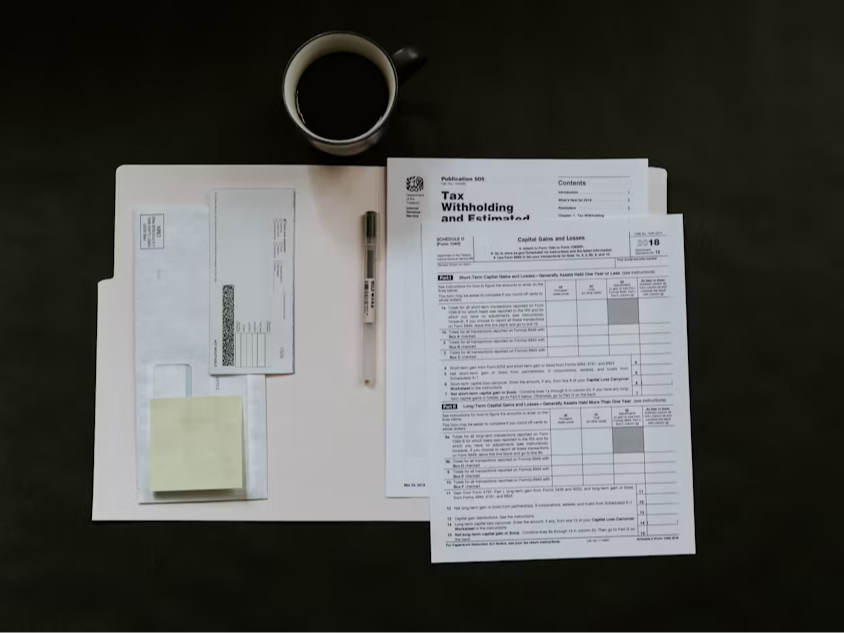
Why JobHun
Not sure how long your resume should be? JobHun helps you find that sweet spot.
With our free AI resume builder and ATS-friendly resume checker, you can create a resume that’s the right length and gets results. Whether it’s one page or two, we’ll help you keep it sharp, clear, and ready to impress.
Go to the JobHun Website
Start by visiting JobHun.com.
Once you're on the homepage, click the 👤 profile icon in the upper-right corner. This will take you to JobHun’s resume builder web app.

Access the Resume Dashboard
You’ll land on webapp.jobhun.com/mine.
If you’re not logged in yet, the site will prompt you to sign up or log in.
- Click the “New Resume” button, or
- Click “Go to Login” in the upper-right corner.
Either option will take you to the sign-in page.
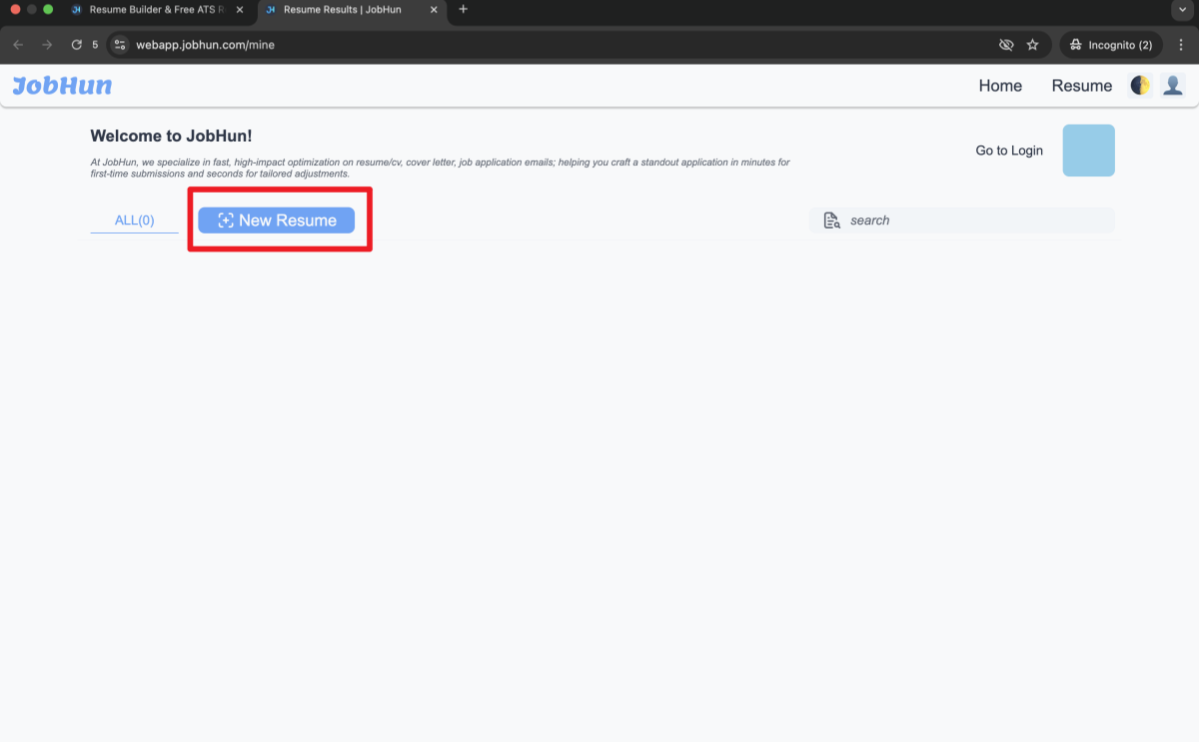
Sign Up or Log In to Your Account
You have two login options:
- Use your Google account for quick access
- Or manually enter your email, password, and name, then click “Go”
Once you're signed in, your personal dashboard will appear.
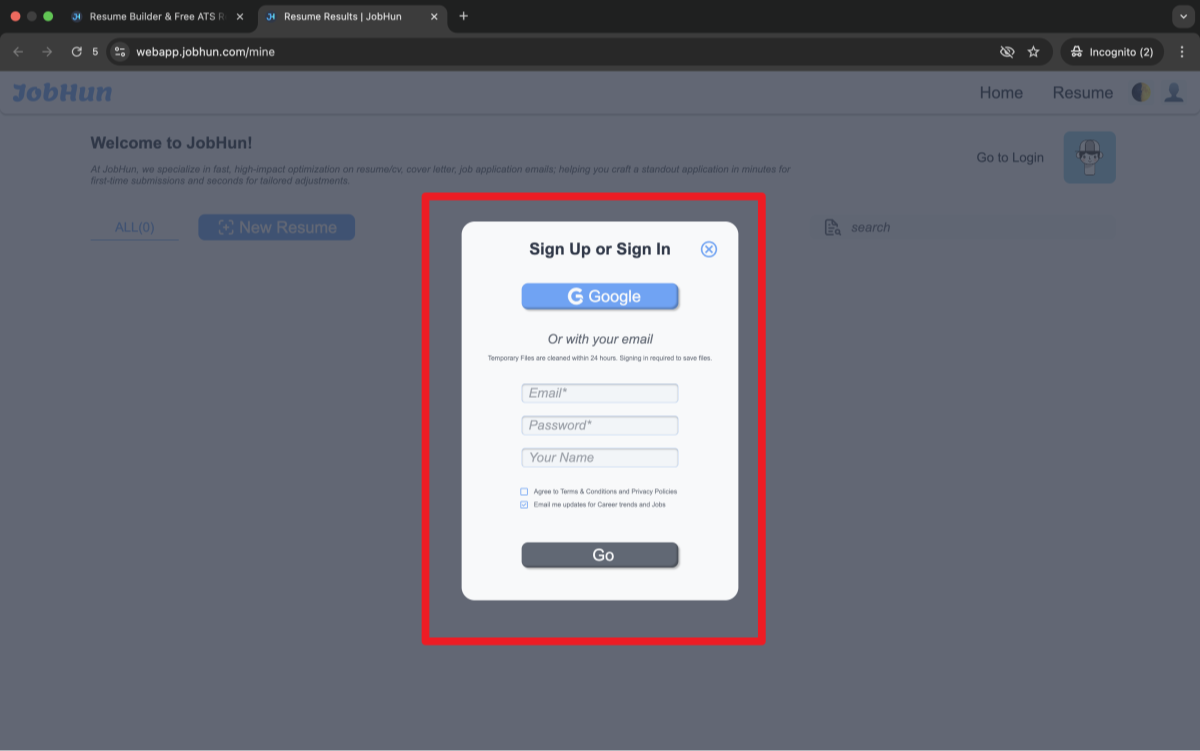
Click “New Resume” to Get Started
Now that you’re logged in, your profile details (name, email, join date) will show in the top-right corner.
Click the “New Resume” button again to open the AI resume builder.
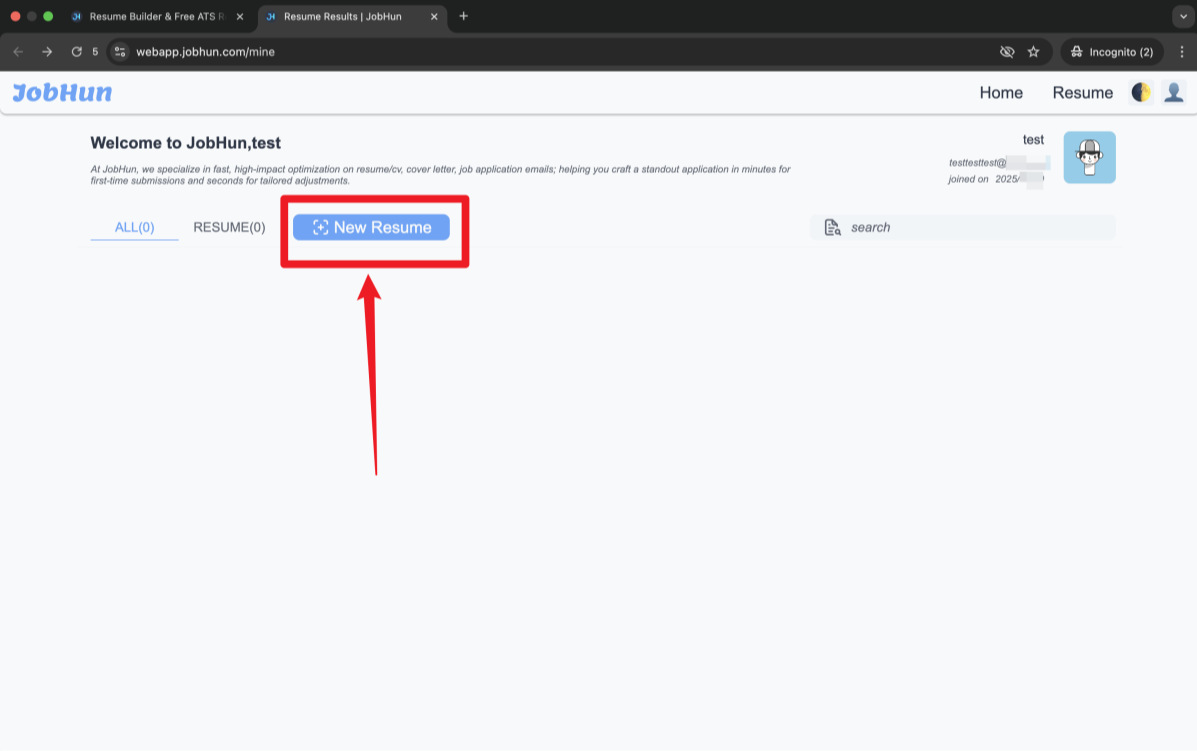
Build and Customize Your Resume
The resume builder layout is split into two main parts:
- Left panel: Your control dashboard, where you can add, edit, or organize resume sections (summary, experience, skills, etc.)
- Right panel: A live preview of your resume that updates as you make changes
You can now:
- Use AI to auto-generate resume content
- Manually edit each section
- Format, reorder, and polish until you're happy with the result
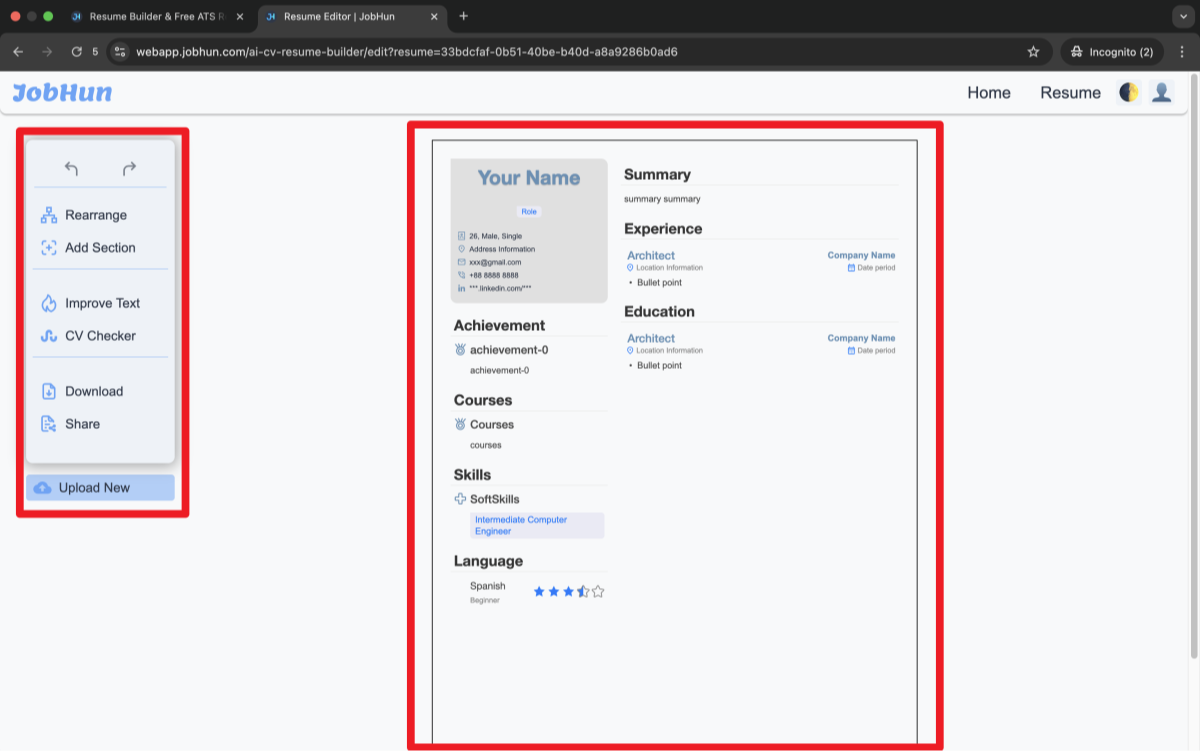
Resume Length by Career Stage
How experienced you are is the biggest factor in page count. As one career guide explains, "for recent graduates... a one-page résumé is usually sufficient. For mid-to-late career professionals, the ideal length is generally two pages". Let's break this down. Curious about formatting? Here’s a step-by-step guide on how to make a resume on Google Docs.
Entry-Level and Early-Career (One-Page Focus)
Just graduated or only a few years into your career? One page is usually best. Think of your resume as an elevator pitch of your professional life so far. You likely have limited work history, so keep the focus on education, internships, projects, and key skills. A one-page resume is "ideal for entry-level workers, new college graduates, and those who have a few years of work experience". If you're new to the job market, check out our resume summary examples for students to craft a strong opening line.
Keeping it to one page forces you to pick what really matters. Highlight academic honors, relevant coursework, volunteer experience, or internships – but only those that add value for the job you want. Use a functional or hybrid format if you lack experience, to emphasize skills over chronology. If you're changing careers with unrelated past jobs, a one-page resume can focus on transferable skills instead of old career details.
That said, one page doesn't have to be stuffing-compressed. Use formatting wisely: margins, white space, bullet points. There's no need to sacrifice readability. If you're tempted to shrink font to pack more in, ask: "Is every word of this resume essential?" If it's just filler, cut it. Remember, it's better for an early-career resume to leave a few things out than to overwhelm the reader with minutiae. The page length here is a tool to stay focused.
In practice: write out all your information, then condense it to the top achievements that showcase your potential. Even if you have space, one page demonstrates confidence and clarity. Many hiring managers prefer one-page resumes for juniors because they can scan them quickly. So as an early-career pro, aim for one page – your accomplishments and enthusiasm will speak louder than length. One-page resumes are ideal for those early in their career—like recent grads or people with limited work history. Pair it with a strong summary for resume with no experience examples to make a lasting impression.
Mid-Career Professionals (Two Pages)
If you have 5–10+ years of experience, you likely need two pages to tell your story. By now, you've probably held multiple roles and built a solid track record. Trying to cram a decade into one page can mean omitting details that show your growth.
A two-page resume gives you room for a powerful professional summary or profile section, plus bullet points for each significant role. It lets you include key projects, leadership duties, and measurable results without cutting corners. For instance, if you led multiple projects or managed a team, those accomplishments need space to shine. You can even add sections like Certifications or Volunteer Work if they're relevant. The key is to remain concise on each page: you don't actually fill two pages with fluff. Treat it like an extended highlight reel, splitting content meaningfully between pages.
That said, use only as much space as needed. ZipJob's experts note that the "optimum length for a resume in 2023 is two pages in order to fit all your keywords, work history, experience, and skills". So if your roles are rich with achievements, a second page is justified. Otherwise, always prioritize the most recent 10–15 years. Older jobs or early volunteer activities beyond that can often be summarized or dropped to save space.
A practical tip: If you do go to two pages, make sure page 1 carries weight. The first page should stand alone as much as possible (with your name and title on both), because some hiring managers may not always read page 2 immediately. In short, mid-career professionals should use two pages, but only because they're packing in career highlights – not because they're adding empty bullet points. Again, quality over quantity is the rule. How do you decide if you need that second page? Think: Does removing that extra info weaken my story? If yes, keep it. If not, maybe cut it.
Senior, Executive, and Special Roles (Beyond Two Pages)
For very senior professionals or special cases, more pages can be acceptable. But this is rare. The rule of thumb is: three pages (or more) typically means you're writing a CV, not a resume. For example, academics, researchers, or government employees often use curriculum vitae that list publications, presentations, and licenses – which easily goes beyond two pages.
Only go to three pages if absolutely necessary – like if you're a federal job applicant or have dozens of publications. Even top executives often can stick to two pages. In fact, Isaacs notes "I've had new grads do well with two-page resumes and top executives do well with only one page". The key word is relevant. For instance, an executive might have a two-page resume highlighting strategic wins. A scientist might have a multi-page CV to cover research history. But in most corporate job searches, keeping it to two pages max remains the norm.
Always remember: the content on those pages matters more than the number of pages. If you think, "My career is too rich to fit on two pages," ask yourself whether all details truly support your current goals. A final rule: if you do use a lengthy resume or CV, consider directing hiring managers to your LinkedIn for extra details, and emphasize only the most recent 10–15 years on paper. This way, you respect their time while still making the most of your extensive career.

One-Page vs Two-Page Resumes: Pros & Cons
Choosing between one or two pages often feels like a tug-of-war between brevity and completeness. Both formats have advantages depending on your situation. Let's compare:
When a One-Page Resume Works
- Conciseness – A one-page resume forces you to be brief and clear. You include only your strongest qualifications, which makes it easy for recruiters to scan quickly. Indeed notes that typically one page is expected, though exceptions exist.
- Attention-Grabbing – Early-career candidates and career-changers benefit from one page because it highlights their top assets (like education, skills) without overloading details. In a sea of applications, a crisp single page stands out.
- Ease of Reading – Recruiters can get the gist of your background at a glance. Remember, the average initial review time is only ~6 seconds. A single page ensures they don't have to hunt through multiple pages to find your best parts.
- Industry Norms – Some fields (e.g., marketing, tech, hospitality) often prefer a one-page resume for all levels, valuing design and directness over comprehensive lists. If you're in a creative field or a fast-paced industry, brevity can show you understand conventions.
- Print-Friendly – If you ever print your resume (for a career fair or walk-in interview), one page is more professional and convenient.
In short, one page shines when every line matters. If you can showcase your role and impact briefly, one page says: "I can communicate clearly without fluff." It's like handing someone a business card that perfectly summarizes you.
When a Two-Page Resume is Better
- More Content – Two pages let you include significant accomplishments and roles, especially if you've had multiple jobs or projects. For mid-career pros, one page might not do justice to years of experience.
- Keyword Coverage – You can incorporate more industry keywords and skills needed to pass ATS filters. ZipJob points out that packing relevant skills on two pages can help an ATS pick you up in searches.
- Detailed Story – Use the first page for a summary and primary roles, and the second page for earlier roles, publications, certifications, or technical skills. This structure still starts with impact but doesn't abandon your full history.
- Trade-Offs – A two-page resume risks longer read time, but most hiring pros prefer two well-organized pages over one cramped page.
- Credibility – For senior-level candidates, a two-page resume can reflect a depth of experience. It demonstrates you've had a substantial career worth noting, and it can be tailored: the second page could highlight leadership achievements and strategy while the first page hooks the reader with core strengths.
Use two pages if every extra bullet adds value. If you find yourself asking, "Should I really remove this accomplishment?", maybe it belongs on page two. But remember: the second page should still be focused. Don't include irrelevant hobbies or every single past job. Just the ones that reinforce why you're the right fit for the role.
Checklist: Choosing Your Resume Length:
If you answer "yes" to any of the first three, a second page might be warranted:
- Do you have 10+ years of relevant experience with significant milestones?
- Are you listing multiple promotions or leadership roles that need context?
- Do you have important projects, certifications, or publications that strengthen your profile?
Always prioritize concise phrasing. If you can quantify achievements or group similar tasks to save space, that's usually better than expanding pages. How do I decide the best resume length?
Quick Comparison Chart
| Aspect | One-Page Resume | Two-Page Resume |
|---|---|---|
| Who It's For | Entry-level, recent grads, career changers, creative fields. | Mid-career, seasoned professionals with extensive experience. |
| Pros | Easy to read in one glance; forces focus on top qualifications; preferred in roles valuing brevity. | Room for detailed achievements; better for technical/leadership-heavy roles; includes more keywords. |
| Cons | Might leave out relevant details; tricky if many accomplishments. | Risk being skimmed quickly; second page may get overlooked if not formatted clearly. |
| Use When | You have up to ~10 years experience or limited relevant roles. | You have 10+ years of experience or multiple relevant roles needing coverage. |
| Formatting Tips | Maximize space (e.g., smaller margins, 11pt font); prioritize most recent content; consider a "skills" section to save lines. | Ensure page 1 is self-contained with critical info; add summaries, and continue with earlier roles on page 2; keep contact and headings on both pages. |
Use this comparison as a guide, not a strict rule. For example, a highly technical professional with 8 years of niche projects may still benefit from two pages. Think of it as: "What will paint the clearest picture for this job?"
CV vs Resume and Formatting Tips
So far, we've focused on resumes, but it's worth briefly touching on CVs and special formats. In the U.S. and Canada, a resume is typically concise (1–2 pages) and tailored for a specific job. A CV (Curriculum Vitae) is a comprehensive career record often used in academia, research, or some government jobs. CVs have no page limit – they detail every degree, publication, conference, etc. LiveCareer notes that while resumes are 1–2 pages, a CV "can extend to 10+ pages" because of its detail. Choosing the best font size for resume can ensure your content looks clean and easy to scan.
Should you write a CV or resume? If you're applying for an academic role or a job overseas where long formats are accepted, you may need a CV. In that case, don't worry about pages – just be thorough. However, most companies expect a resume for initial job applications. If your CV is 5+ pages, consider keeping only the highlights on your resume and linking the full CV in a portfolio or LinkedIn. Your file name matters too—learn how to pick the right resume file name that looks professional to employers.
Formatting & ATS Considerations
Regardless of length, formatting can help you make the most of every page. Here are some easy-to-understand tips (think of them as finishing touches on a recipe):
- Bullet Points: Use bullets for your achievements. Each should be brief (1–2 lines) and start with a strong action verb. Remember the Action-Task-Result formula; this keeps bullets concise and impactful. Most will stay under two lines. This also makes your resume scannable.
- Margins & Font: Keep margins around 0.7–1 inch and font size 11–12pt. You can slightly shrink margins or font to fit content, but not so much that it's hard to read. One-inch margins are standard, and 10pt is usually the smallest readable font.
- White Space: Resist cramming graphics, tables, or images (except perhaps a simple divider line). ATS systems prefer plain layouts. A clean format with headings (Work Experience, Education, etc.) helps both bots and humans follow your story. Complex columns or text boxes can confuse ATS parsing.
- Colors & Style: A touch of color (like dark blue section headers) can make a printed resume pop, but use it sparingly. Avoid bright backgrounds or unusual fonts. A professional look keeps the focus on content. The goal is clarity, not creativity.
- Tailoring: Most importantly, tailor your resume to each job. That might mean adjusting your summary, shuffling bullet points, or even removing a second page if the job only needs one page's worth of info. Always review the job description keywords and sprinkle them in naturally.
And remember, you don’t have to do it alone! Modern tools can help optimize your resume:
- Free AI Resume Builder: Try using our free AI resume builder to help structure and phrase your content. These builders often include smart templates that make full use of space.
- ATS-Friendly Resume Checker: Once your draft is ready, run it through an ATS-friendly resume checker (or search “free ATS resume checker”). It will tell you if any sections are unreadable by hiring software or if you’re missing key formatting. Our AI resume checker can point out filler words or suggest stronger verbs, ensuring every word earns its keep.
- Peer Review: Finally, have a friend or mentor look at both pages (or just page one). If the feedback is “This really showcases you well,” you’re on target. If they say “I’m not sure what you did at that job,” consider rewriting or cutting that part.
By combining these formatting tips with our resume builder online tool, you’ll create a polished, professional-looking resume that fits the ideal length for you. Keep in mind: fewer pages doesn’t automatically mean better, but each page should be easy to digest and free of clutter. Wondering about headers and structure? Here's whether you should have a running header on your resume.
Frequently Asked Questions
Q: How many pages should my resume be if I’m an entry-level professional?
A: For early-career candidates (internships, recent grads, 0–5 years experience), one page is usually best. Focus on coursework, internships, skills, and any standout projects. Only include a second page if you truly have multiple relevant experiences that one page can’t cover. Even then, tailor content tightly.
Q: Is a two-page resume okay for a junior professional?
A: It can be, if you’ve held several roles or have extensive skills to showcase. However, be cautious. If your resume is stretching to two pages with just a couple of years of experience, it might seem padded. The advice is to try keeping it concise. Use a two-page format mainly when you have 5+ years of significant experience or special certifications that need space.
Q: Should a resume ever be three pages long?
A: Almost never—three pages is typically too long for most jobs. Very few cases require it, and those are usually for academic or research CVs, government, or highly technical fields. Even then, if your resume hits three pages, consider trimming older or less relevant work. Remember that most hiring managers lose interest after page two. If you need a space to list every publication or project (like in academia), label it a CV instead. For standard roles, stick to one or two pages at most.
Q: How do I know if my resume is too long?
A: Read it from a recruiter’s perspective. If the core of your qualifications fits on the first page with some eye-catching highlights, it’s unlikely the second page is being ignored. A resume is “too long” if you can remove a paragraph or bullet point without losing the story of why you’re a fit. If you find filler or outdated info (like high school achievements when you have a college degree), cut those. Use tools or ask for feedback. If they say “Wow, this really tells me who you are,” you’ve likely found a good length. If they look overwhelmed or bored, it’s time to trim.
Q: What’s the difference between a CV and a resume in terms of length?
A: In general, a resume is 1–2 pages and tailored for a specific role, whereas a CV (Curriculum Vitae) is a full career summary that can be 3+ pages. CVs list all publications, presentations, licenses, etc., and are common in academia, medicine, or overseas. Unless your job application specifically asks for a CV, you should stick to a concise resume. If an employer asks for a resume, assume they expect one or two pages.
Q: What if I have to include lots of volunteer work or side projects?
A: Only list volunteer experiences, awards, or hobbies if they are relevant to the job or demonstrate transferable skills. Remember, every line of your resume should serve your application. If volunteer work filled many years but isn’t needed for the job, consider summarizing it in one line or leaving it off. Focus space on professional experiences and achievements. If those extras are important, you might justify a longer resume, but first exhaust all options of merging or simplifying content.
By addressing these common concerns, you’ll be well on your way to a resume that’s just the right length for your story. How many pages should a resume be? The answer is: just long enough to showcase your value.




